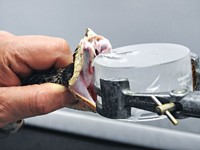Advertisement
Grab your lab coat. Let's get started
Welcome!
Welcome!
Create an account below to get 6 C&EN articles per month, receive newsletters and more - all free.
It seems this is your first time logging in online. Please enter the following information to continue.
As an ACS member you automatically get access to this site. All we need is few more details to create your reading experience.
Not you? Sign in with a different account.
Not you? Sign in with a different account.
ERROR 1
ERROR 1
ERROR 2
ERROR 2
ERROR 2
ERROR 2
ERROR 2
Password and Confirm password must match.
If you have an ACS member number, please enter it here so we can link this account to your membership. (optional)
ERROR 2
ACS values your privacy. By submitting your information, you are gaining access to C&EN and subscribing to our weekly newsletter. We use the information you provide to make your reading experience better, and we will never sell your data to third party members.
Proteomics
Chemical cocktail allows cobra to spit pain
Scientists find that three types of snakes evolved the same chemical defense independently
by Laura Howes
February 2, 2021
The Liverpool School of Tropical Medicine has one of the largest collections of venomous snakes in the UK. Most of the snakes found there are biters; they produce venoms that they inject through their fangs to immobilize and kill their prey. But some snakes will also spit . . . in your face. “It’s just part of the job that you will get spat at,” explains Nicholas Casewell, director of the school’s Center for Snakebite Research & Interventions. Three types of snakes—African spitting cobras, Indian spitting cobras, and rinkhals—react to threats from humans by projecting venom multiple meters toward the eyes. In the lab, Casewell says, researchers wear visors or face masks, but when the venom hits unprotected eyes it causes pain, inflammation, and even blindness. Now researchers understand the molecular basis of spitting snakes’ venom cocktail. The venom spit by these snakes carries high levels of proteins that enhance the pain sensation triggered in mouse nerve cells by the venom (Science 2021 DOI: 10.1126/science.abb9303).
To understand how the snakes evolved this defensive skill, Casewell and his lab teamed up with researchers from eight countries to build the spitting snakes’ genetic history. They found that the three types of snakes evolved their incredibly similar defensive technique independently, a process called convergent evolution.
The researchers used mass spectrometry and other analytical techniques to compare the venom proteins from different snake species. That meant getting snakes to spit on demand. Taline Kazandjian, a postdoctoral research associate from Casewell’s group, stuck a crude face onto a clear plastic face shield as a first attempt to induce the spitting, and it worked. A dark circle with two light circles representing eyes drawn on the shield was enough to make the snakes spit. Kazandjian could then scrape the thick venom off the shield for testing.
The team found that while each snake has a different mix of toxins in their venom, including toxins found in venom of non-spitting snakes, all the spitting snakes have increased levels of phospholipase A2 (PLA2) enzymes compared with the non-spitting snakes. The researchers tested the venom components on mouse sensory nerve cells and found that when the PLA2 toxins are added to the other venom components many more nerve cells are activated than if the PLA2 toxins aren’t present, indicating a larger pain response. That combination makes a particularly painful concoction when it gets in the eyes, says Casewell.
“This work provides rare insights into the evolution of defensive venoms,” says snake venom expert Kartik Sunagar of the Indian Institute of Science in Bangalore, noting that venoms used for defense have not previously been investigated. “It is remarkable how very distantly related animals strike upon identical molecular solutions to problems,” he adds.
Spitting snakes also have a nasty bite that causes “really horrific local tissue damage,” Casewell says. There is no evidence that the snakes' venom differs between spits and bites, he adds, but his group is working to find out.





Join the conversation
Contact the reporter
Submit a Letter to the Editor for publication
Engage with us on Twitter